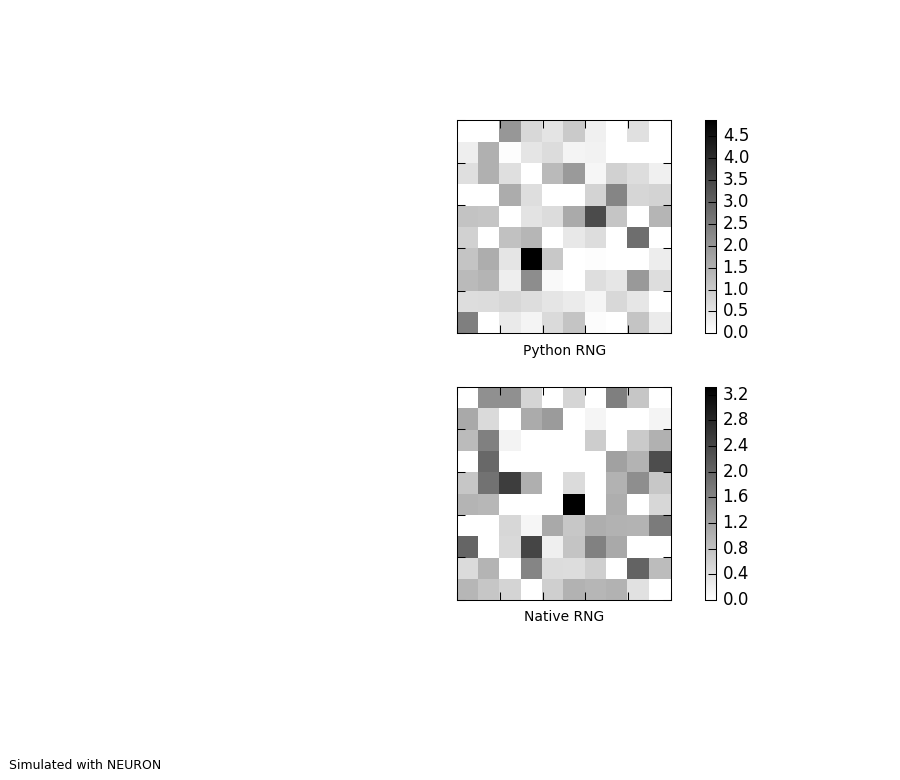"""
An example to illustrate random number handling in PyNN
In particular, this shows the difference between "native" and Python random number generators.
If you run this script with two different simulators, e.g. NEST and NEURON,
the weight matrix created with the Python RNG will be the same for both simulations,
the weights created with the native RNG will be different in the two cases.
The potential advantage of using a native RNG is speed: for large networks, using
the `NativeRNG` class can reduce network construction time, but at the expense of
cross-simulator repeatability.
Usage: random_numbers.py [-h] [--plot-figure] [--debug DEBUG] simulator
positional arguments:
simulator neuron, nest, brian or another backend simulator
optional arguments:
-h, --help show this help message and exit
--plot-figure plot the simulation results to a file
--debug DEBUG print debugging information
"""
import numpy
from pyNN.random import NumpyRNG, RandomDistribution
from pyNN.utility import get_simulator
# === Configure the simulator ================================================
sim, options = get_simulator(
("--plot-figure", "plot the simulation results to a file", {"action": "store_true"}),
("--debug", "print debugging information"))
sim.setup()
# === Create random number generators ========================================
python_rng = NumpyRNG(seed=98497627)
native_rng = sim.NativeRNG(seed=87354762)
# === Define the neuron model and initial conditions =========================
cell_type = sim.IF_cond_exp(tau_m=RandomDistribution('normal', (15.0, 2.0), rng=python_rng)) # not possible with NEST to use NativeRNG here
v_init = RandomDistribution('uniform',
(cell_type.default_parameters['v_rest'], cell_type.default_parameters['v_thresh']),
rng=python_rng) # not possible with NEST to use NativeRNG here
# === Create populations of neurons, and record from them ====================
p1 = sim.Population(10, sim.SpikeSourcePoisson(rate=100.0)) # in the current version, can't specify the RNG - it is always native
p2 = sim.Population(10, cell_type, initial_values={'v': v_init})
p1.record("spikes")
p2.record("spikes")
p2.sample(3, rng=python_rng).record("v") # can't use native RNG here
# === Create two sets of synaptic connections, one for each RNG ==============
connector_native = sim.FixedProbabilityConnector(p_connect=0.7, rng=native_rng)
connector_python = sim.FixedProbabilityConnector(p_connect=0.7, rng=python_rng)
synapse_type_native = sim.StaticSynapse(weight=RandomDistribution('gamma', k=2.0, theta=0.5, rng=native_rng),
delay=0.5)
synapse_type_python = sim.StaticSynapse(weight=RandomDistribution('gamma', k=2.0, theta=0.5, rng=python_rng),
delay=0.5)
projection_native = sim.Projection(p1, p2, connector_native, synapse_type_native)
projection_python = sim.Projection(p1, p2, connector_python, synapse_type_python)
# === Print the synaptic weight matrices =====================================
weights_python = projection_python.get("weight", format="array")
weights_native = projection_native.get("weight", format="array")
print(weights_python)
print(weights_native)
# === Run the simulation =====================================================
sim.run(100.0)
sim.end()
# === Optionally, plot the synaptic weight matrices ==========================
if options.plot_figure:
from pyNN.utility import normalized_filename
from pyNN.utility.plotting import Figure, Panel
filename = normalized_filename("Results", "random_numbers", "png", options.simulator)
# where there is no connection, the weight matrix contains NaN
# for plotting purposes, we replace NaN with zero.
weights_python[numpy.isnan(weights_python)] = 0
weights_native[numpy.isnan(weights_native)] = 0
Figure(
Panel(weights_python, cmap='gray_r', xlabel="Python RNG"),
Panel(weights_native, cmap='gray_r', xlabel="Native RNG"),
annotations="Simulated with %s" % options.simulator.upper()
).save(filename)
print(filename)

